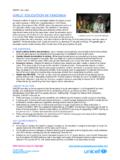Transcription of Gender Equity: Still Knocking at the Classroom Door
1 Gender equity : Still Knocking at the Classroom Door David Sadker Educational Leadership, Vol 56 April 1999 (All Rights Reserved. Please do not print without author s permission.) Gender equity ? Oh, yes, that was big a few years ago. Today, girls home ec and boys shop are gone. Girls get better grades. Girls are more likely to get into college, while boys are more likely to get into trouble. Why all this attention to girls? Boys are the ones in trouble. Title IX? Wasn t that repealed? Many educators are confused about Gender equity . Is it Still a problem? Is it more "political correctness" than educational effectiveness? Wasn t that battle fought and won years ago. Until 1980, Ivy League schools like Columbia University would not even admit women. Today, women are the majority of college students. Perhaps it is time to declare victory and move on. Michael Kazin, in his new book, Like a Civil War: The United States in the 1960s (Oxford University Press, 2000), helps educators understand the cultural context surrounding educational equity .
2 Kazin writes that in the virtual civil war between liberals and conservatives that characterized the 1960s, it was actually the conservatives who won most of the battles. Today s cultural landscape is littered with their mantras, now part of the national conventional wisdom: government is too big, taxes are too high, affirmative action is unfair, business is overregulated, and school choice will improve education. But conservatives did not win all the battles. Kazin believes that the most successful social crusade to emerge from that turbulent decade may well have been feminism, a movement that restructured American society. But not everyone concurs. Ultraconservative commentators take to the airwaves to proclaim that Gender bias no longer exists, except for the men victimized by feminists. Their efforts have not been without success: today the word feminist carries as much negative as positive connotation.
3 So what is an educator to believe? Even if the politicalization of Gender equity were not in high gear, Gender equity would face an uphill struggle. Each time I begin a training program to enable educators to detect and eliminate bias from their Classroom teaching, I am reminded of what some call Gender blindness (Bailey, Scantlebury & Letts, 1997, p. 29). Often I show a videotape with subtle, if pervasive, Gender bias. Asked to evaluate the tape, most teachers miss the bias. After a few minutes practicing some rudimentary coding of Classroom interactions, we go "back to the tape." Surprise, surprise! Now the Gender bias is overwhelming. No longer political or personal, the bias has become a research reality, their reality, and the teachers are motivated to create equitable teaching strategies. Why the initial Gender block? In Failing at Fairness (Touchstone, 1995), Myra and I talked about "a syntax of sexism so elusive that most teachers and students were completely unaware of its influence.
4 " It is Still elusive, and many teachers Still miss it. Teacher education and staff development programs do little to prepare teachers to "see" the subtle, unintentional, but damaging Gender bias that characterizes classrooms. But subtlety is not the only reason for the persistence of inequity: a false sense of accomplishment has also taken root. We have made wonderful advances, especially in the area of access to schools, courses and careers. While bias is less problematic today, it s influence is no less virulent. The American School Board Journal recently reported a story about ten-year-old Karen, who wanted to change her seat on the school bus. "I ve seen everything out my window," she explained. Her school district in San Pasqual Valley, California, separates boys and girls for the ride to school. The school policy is that boys sit on the left, girls on the right. Karen was told that she would have to stay on the girls side of the bus.
5 Segregation on buses conjures up images of Rosa Parks and the freedom riders of the 1960s. In the 1990s, however, rather than "move to the back of the bus," we now have "move to the side of the bus." For this California school district, Gender segregation begins even before students arrive. The story underscores the countless ways, formal and informal, that schools resist change. A quarter of a century of Title IX has not undone these school practices. This article provides an update of salient and current research on Gender progress and problems in schools (American Association of University Women Educational Foundation, 1998). In addition, the article touches upon some of the disturbing cultural developments that have distorted and politicized educational equity . If I can borrow a device used by a Late Night television host, let s begin with a top ten list. The Top Ten Gender Bias Updates Update #10: Segregation Still thrives in America s schools.
6 Title IX has breached the walls of The Citadel and the Virginia Military Institute, and females are now admitted to virtually all tax supported educational institutions. Too often, however, courses of study and careers remain Gender segregated. Females major in English, French, Spanish, music, drama, dance, while males populate computer science, physics, and engineering. A recent study of 14 School-to-Work sites revealed that over 90 percent of females cluster in five traditional careers. Although almost half of medical and law students are female, they are concentrated in a few female-friendly (and lower paying) specialties. Update #9: Public schools are now creating single Gender classes and schools. Over a century ago, most schools were Gender segregated. Many private schools Still are. And the research on their effectiveness, at least for the girls, is compelling, if not universally accepted.
7 In response to this research, and to the pressures brought by assertive parents (usually of girls), public school districts have openly (and sometimes surreptitiously) created their own single sex classes or schools. Is this a positive or a negative development? If we were to carefully implement and research a limited trial of single Gender public schools and classes, the findings could improve public coed schools for boys as well as girls. However, the current approach has the potential of fractionalizing our society, diverting us from the task of creating unbiased schools. Creating single Gender classes and schools is not a substitute for the equitable public education of all our students. Update #8: Gender related safety and health concerns continue to plague females. One hundred years ago, the argument against female education centered on health. Doctors warned that education redirected blood, initially destined for the ovaries, to the brain.
8 The result: educated women were less likely to reproduce and more likely to go insane. The doctors prescription: keep girls out of school. Bizarre, but a sign of how female health issues were viewed. Today, our attention turns to more genuine and pressing health risks to consider. Twenty percent of school age girls report being physically or sexually abused, while 80 percent report that they had experienced some form of sexual harassment. Although research shows that physical activity for girls leads to higher self-esteem and life-long health benefits, girls are only half as likely as boys to participate in physical education. Update #7: The dropout rate is not what we think it is. Most educators and the public at large know that boys repeat grades and drop out of school at a higher rate than girls. However, few realize that girls who repeat a grade are more likely to dropout of school than male grade repeaters.
9 When girls drop out of school, often due to pregnancy, they are less likely to return and complete school than boys. In 1995, for example, approximately one third of Hispanic females between 16 and 24 had not completed school, and had not passed a high school equivalency test. While boys drop out with a "crash," girls dropout more quietly, more quickly, and more permanently. Update #6: For girls, gifted programs are often "early in and early out." Girls are identified in equal or greater numbers for elementary school gifted programs than boys. However, by tenth grade a reversal occurs and girls begin to drop out at a higher rate than boys. Boys are more likely to be found in math and science gifted programs, and while girls populate gifted programs that focus on language arts. For both girls and boys, gifted programs often reinforce Gender segregation. Update #5: More needs to be done to understand and eliminate the Gender bias that impacts males.
10 Because men earn more money, manage most organizations, dominate both government offices and sports arenas, many Americans assume that they are the victors in the great Gender divide. In fact, sexism harms, and Title IX protects, both genders. Boys are stereotyped into their Gender roles earlier and more harshly than females. Three out of four boys report being the targets of sexual harassment, usually in the form of taunts challenging their masculinity. Males who express an interest in careers atypical for their Gender also encounter social pressures. The percentage of males in elementary teaching, for instance, is smaller today than when Title IX was written a quarter of a century ago. While females receive lower grades on standardized tests, males receive lower course grades. Males are less likely to have close friends and more likely to endure alienation and loneliness at every stage of life.







